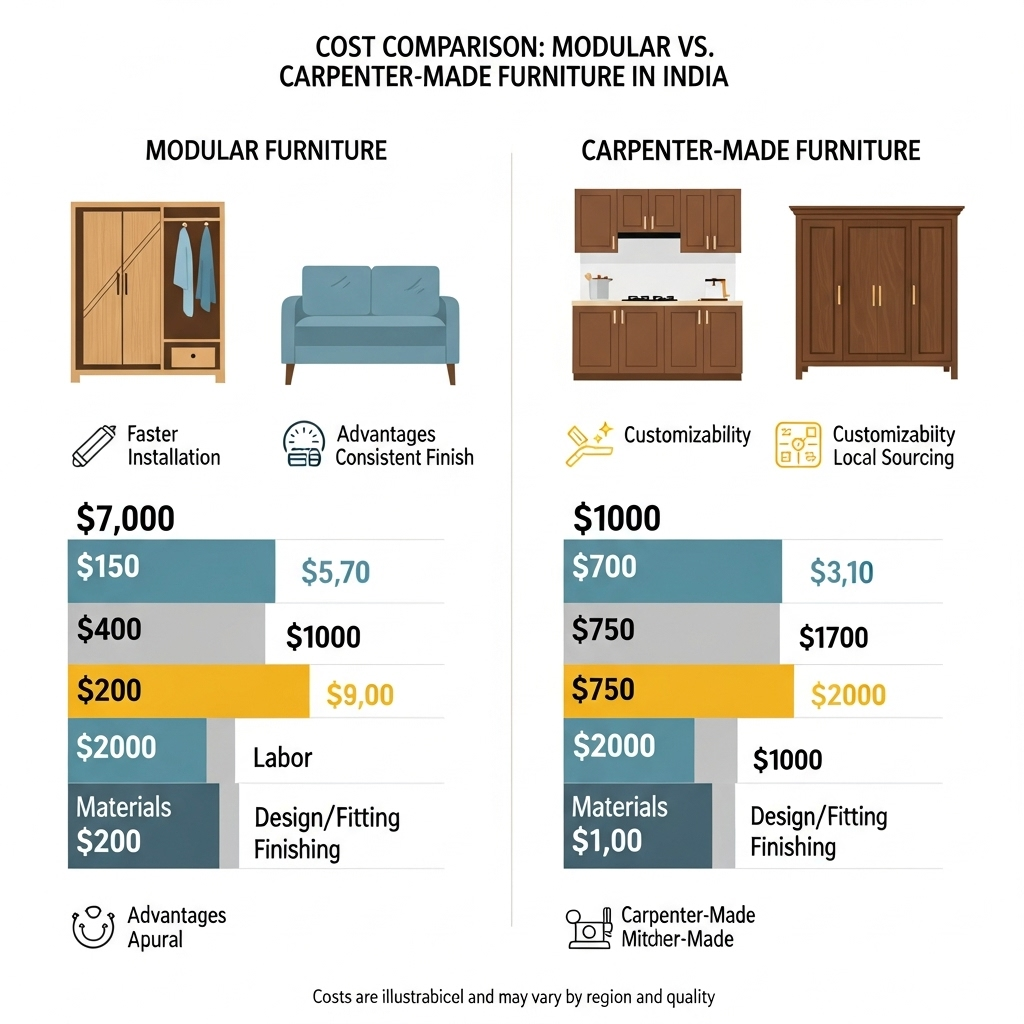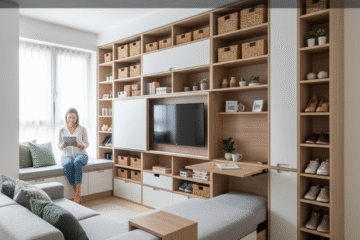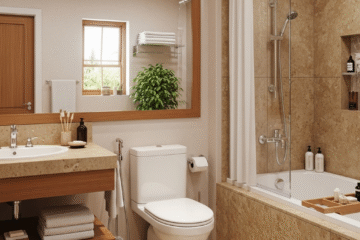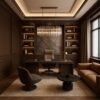
Cost Comparisons (Modular vs Carpenter)
When planning home interiors, one of the most debated topics is Modular vs Carpenter Furniture Costs – clear, search-friendly, and natural.. Homeowners often face the dilemma of choosing between sleek modular setups offered by branded companies and traditional carpenter-made furniture crafted on-site. Both options have unique advantages, price differences, and long-term implications.
The decision doesn’t just affect your budget—it also impacts quality, timelines, and resale value. Understanding the real Modular vs Carpenter Furniture Costs – clear, search-friendly, and natural. helps you make an informed choice that balances style, durability, and affordability.
SPACE – Suggestion: Confused about choosing modular or carpenter interiors?
Get a detailed cost comparison plan at InteriorGrid.com today!
Table of Contents
Why Cost Comparisons Modular vs Carpenter Matter
Modular vs Carpenter: Making the Right Choice for Your Interiors
Choosing interiors is a long-term investment, and Modular vs Carpenter comparison is crucial to ensure you get the best value. When deciding between Modular vs Carpenter, it’s important to weigh financial aspects, quality, and long-term usability.
1. Modular vs Carpenter Financial Clarity
A detailed comparison of Modular vs Carpenter costs gives you complete financial clarity. With Modular vs Carpenter, you can know exactly what you are paying for—materials, labor, and design—without surprises. Unlike traditional carpentry, Modular vs Carpenter pricing is often transparent and fixed, helping homeowners budget efficiently.
2. Modular vs Carpenter Quality Control
When it comes to longevity, Modular vs Carpenter quality matters. Modular interiors are factory-made, ensuring consistent quality, while Modular vs Carpenter carpentry depends heavily on individual craftsmen. Choosing Modular vs Carpenter wisely can save you future maintenance costs and ensure durable interiors.
3. Modular vs Carpenter Transparency
Transparency is a major advantage in Modular vs Carpenter decisions. Modular solutions offer predefined costs, timelines, and materials, while traditional carpentry may involve hidden charges. Evaluating Modular vs Carpenter options carefully ensures no unexpected overruns.
4. Modular vs Carpenter Value for Money
When considering ROI, Modular vs Carpenter value for money becomes the key factor. Modular interiors provide standardized quality and faster execution, whereas Modular vs Carpenter carpentry may vary in efficiency. Comparing Modular vs Carpenter allows homeowners to select an option that maximizes their investment.
5. Modular vs Carpenter Design Flexibility
Design flexibility is another important aspect in Modular vs Carpenter decisions. Modular interiors offer customizable modules, whereas Modular vs Carpenter carpentry depends on manual skill. Choosing Modular vs Carpenter appropriately ensures you get interiors that match both style and functionality.
6. Modular vs Carpenter Installation & Time Efficiency
Time efficiency is critical in interior projects. Modular vs Carpenter comparison shows that modular solutions save time due to pre-fabrication. Understanding Modular vs Carpenter differences helps in planning project timelines effectively.
Selecting between Modular vs Carpenter is more than just a cost decision. By analyzing Modular vs Carpenter in terms of financial clarity, quality, transparency, value, and flexibility, homeowners can make an informed long-term investment. Remember, the right Modular vs Carpenter choice ensures interiors that are stylish, durable, and budget-friendly.
💰 Discover which option saves more in the long run without compromising quality.
👉 Compare Modular & Carpenter Costs Now
What is Modular Furniture?
Modular furniture is factory-made, designed in pre-fabricated units, and assembled on-site.
Features:
• Precision manufacturing.
• Available in multiple finishes like laminates, acrylic, veneer, glass.
• Easy to dismantle, repair, and shift.
• Backed by company warranties.
What is Modular Furniture?
Modular furniture refers to pre-fabricated furniture pieces manufactured in factories and designed in standard units that can be easily assembled on-site. Unlike traditional handcrafted furniture, modular pieces are produced with precision machinery, ensuring uniform quality and finish across all components. Modular furniture is ideal for modern homes and apartments because it is versatile, space-efficient, and aesthetically consistent.
Key Features of Modular Furniture:
- Precision Manufacturing: Each unit is machine-cut and engineered for exact dimensions, which ensures seamless alignment during installation.
- Variety of Finishes: Modular furniture is available in multiple finishes including laminates, acrylic, veneer, and tempered glass, allowing homeowners to match different interior styles.
- Easy to Dismantle and Shift: Modular units are designed for portability. This makes it convenient to relocate or reconfigure furniture as per the layout of the home.
- Backed by Warranties: Most branded modular furniture comes with manufacturer warranties covering hardware, finishes, and installation, providing peace of mind for homeowners.
- Quick Installation: Since components are prefabricated, installation is faster than custom-built furniture, reducing labor costs and time.
Advantages of Modular Furniture in Modern Homes:
- Efficient use of space, particularly in small or irregular rooms.
- Standardized fittings ensure compatibility across units.
- Supports integrated storage solutions like pull-out drawers, soft-close hinges, and concealed compartments.
- Ideal for contemporary minimalist designs with clean lines and sleek finishes.
What is Carpenter-Made Furniture?
Carpenter-made furniture is handcrafted by local carpenters or artisans directly at your home or workshop. Unlike modular furniture, it is entirely customized based on client preferences, room dimensions, and material choices. Carpenter furniture is suitable for traditional designs or unique requirements that cannot be fulfilled by standard modular units.
Key Features of Carpenter-Made Furniture:
- Fully Customized: Every piece is tailored according to the homeowner’s specific design preferences, including intricate detailing and custom dimensions.
- Skill-Dependent: The quality of the finished product largely depends on the skill, experience, and craftsmanship of the carpenter.
- Material Choices: Typically uses plywood, MDF, blockboard, or solid wood, offering flexibility in material selection but varying in durability.
- Repair and Upgrade Flexibility: Since it is locally crafted, maintenance, repairs, or upgrades can usually be handled by the carpenter, though quality depends on local availability and expertise.
- Time-Intensive Installation: Each piece is built on-site, often requiring more time compared to modular furniture installation.
Advantages of Carpenter-Made Furniture:
- Unlimited customization options including design, size, and material.
- Can incorporate traditional or intricate design elements.
- Often more cost-effective for basic designs.
- Supports local craftsmanship and artisans.
Cost Comparisons: Modular vs Carpenter – Kitchen Interiors
Modular Kitchen Costs:
- Basic Finishes (Laminate): ₹1.5–2.5 lakhs for a mid-sized kitchen.
- Premium Finishes (Acrylic, Veneer): ₹3–6 lakhs, depending on materials and design complexity.
- Additional Benefits: Includes branded hardware, installation, and warranties for long-term peace of mind.
Carpenter Kitchen Costs:
- Laminate Finishes: ₹80,000–2 lakhs.
- Premium Veneer or Plywood: ₹2–4 lakhs, depending on material quality and carpenter charges.
- Limitations: No standard warranty; cost and quality vary with the carpenter’s expertise.
Factors Affecting Costs:
- Choice of materials (MDF, plywood, acrylic, veneer).
- Size and complexity of the kitchen layout.
- Hardware quality (soft-close hinges, branded handles).
- Labor and installation charges.
Cost Comparisons: Modular vs Carpenter – Wardrobes
Modular Wardrobes:
- Sliding Wardrobes: ₹80,000–2 lakhs depending on size, material, and brand.
- Hinged Wardrobes: ₹50,000–1.5 lakhs with premium fittings.
- Features: Soft-close hinges, branded hardware, customizable interiors, and integrated lighting.
Carpenter Wardrobes:
- Hinged Wardrobes: ₹30,000–1 lakh depending on material and labor.
- Sliding Wardrobes: ₹60,000–1.5 lakhs depending on design.
- Features: Fittings and accessories are sourced by the carpenter, quality may vary, and no formal warranty is provided.
Internal Link Placeholder: InteriorGrid.com/rental-storage-solutions
Pros and Cons of Modular Furniture
Modular furniture has become a popular choice for modern homes, especially in urban apartments and rental properties. Its combination of flexibility, speed, and style makes it a go-to solution for homeowners who want functional yet aesthetically pleasing interiors. However, like any design choice, modular furniture comes with its advantages and limitations. Understanding the pros and cons helps in making an informed decision for your home makeover.
Pros of Modular Furniture
- Factory-Level Precision and Quality
One of the biggest advantages of modular furniture is the high level of precision achieved at the factory. Each component is pre-cut, assembled, and finished under strict quality standards, ensuring uniformity across all modules. Unlike traditional carpenter-made furniture, which may vary slightly from piece to piece, modular units maintain consistent quality, providing a polished and professional look. - Quick Installation
Modular furniture is designed for easy and fast installation. Since the components are pre-fabricated, they can be assembled on-site in a fraction of the time it would take to build custom furniture from scratch. This not only reduces labor costs but also minimizes inconvenience for families, professionals, and tenants during renovations or relocations. - Warranty and After-Sales Service
Most modular furniture providers offer warranties and after-sales support, giving homeowners peace of mind. In case of defects, wear-and-tear, or hardware issues, the company can provide repairs or replacements, ensuring that your investment is protected over time. - Flexibility to Dismantle, Upgrade, or Shift
Modular furniture is highly adaptable, which makes it ideal for renters or people who frequently relocate. Units can be dismantled, moved, or reconfigured without causing damage. You can also upgrade individual modules—like adding more shelves or extending a wardrobe—without replacing the entire unit, offering long-term value and convenience. - Clean, Contemporary Aesthetics
Modular designs are standardized and minimalist, which aligns well with modern interiors. Clean lines, smooth finishes, and cohesive layouts help create a contemporary and organized look. Whether it’s a modular kitchen, wardrobe, or TV unit, these designs contribute to a sleek, uncluttered ambiance that is visually appealing and easy to maintain.
Cons of Modular Furniture
- Higher Initial Cost
While modular furniture saves time and offers convenience, the upfront cost can be higher than basic carpenter-made alternatives. The factory precision, branded materials, and after-sales support all contribute to a premium price tag. However, considering the durability, maintenance savings, and flexibility, this investment often pays off over time. - Limited Customization
Modular furniture is generally based on pre-designed modules, which can restrict full customization. Homeowners with highly specific layouts or design preferences may find that certain dimensions or features are not available in modular options. This limitation may require compromises or additional adjustments to fit the space perfectly. - Repairs May Require Company Service
Unlike traditional furniture that can often be repaired locally by a carpenter, modular units usually require company service for specific parts or replacements. This can be a minor inconvenience if repairs are needed urgently, especially in areas where authorized service centers are not nearby.
Final Verdict
Modular furniture is ideal for those seeking efficiency, durability, and modern aesthetics. It saves installation time, provides flexibility, and comes with warranty-backed peace of mind. However, homeowners should weigh the higher initial cost and limited customization against the long-term benefits. For apartments, rentals, or fast-paced urban lifestyles, modular furniture often proves to be a smart and practical choice.
Pros and Cons of Carpenter Furniture
Carpenter furniture has been a traditional choice for homeowners for decades, offering customization and affordability that appeals to many. Unlike modular furniture, which comes pre-fabricated, carpenter-made furniture is created on-site according to the exact specifications of the home. While it has several advantages, there are also some limitations that homeowners should consider before deciding.
Pros of Carpenter Furniture
- Fully Customizable to Exact Room Dimensions
One of the strongest advantages of carpenter furniture is its high level of customization. Every piece is crafted to fit the exact dimensions of your rooms, ensuring maximum utilization of space. Whether it’s a slanted ceiling, an unusual corner, or an irregular wall, a skilled carpenter can design furniture that perfectly fits your space. This level of personalization is ideal for homeowners with unique layouts or specific design visions. - Lower Cost for Basic Designs
For simple furniture needs, carpenter-made solutions are often more budget-friendly than modular alternatives. If you require basic wardrobes, shelves, or tables without premium finishes, hiring a local carpenter can be more economical. Labor and material costs can be adjusted based on your budget, giving you flexibility in choosing affordable options. - Local Repair and Modification Options
Unlike modular furniture that may require company service for repairs, carpenter furniture can be easily repaired or modified locally. Broken hinges, worn-out drawers, or minor scratches can be fixed quickly by a local carpenter, saving time and additional costs. This is particularly useful in case of wear and tear over the years. - Flexible Payment and Negotiation Options
Hiring a carpenter often allows for flexible payment terms. Homeowners can negotiate costs, pay in installments, or adjust the budget based on material choices. This direct interaction with the craftsman provides more control over spending and ensures that specific requirements are met without hidden charges.
📊 Learn the hidden costs, durability factors, and value for money before you decide.
👉 Get a Free Cost Breakdown Guide
Cons of Carpenter Furniture
- Quality Depends on Skill
The quality of carpenter furniture varies significantly based on the skill of the individual carpenter. A highly experienced craftsman can deliver excellent results, but inconsistency in craftsmanship can lead to uneven finishes, misaligned joints, or furniture that doesn’t last as long as expected. - No Formal Warranty
Carpenter furniture generally comes without any formal warranty. Unlike modular furniture that includes factory-backed warranties on hardware and finishes, repairs or replacements for carpenter furniture are the homeowner’s responsibility. This lack of assurance can be a drawback for those seeking long-term security. - Longer Execution and Installation Time
Since carpenter furniture is made on-site, the execution and installation process takes longer. Every piece is measured, cut, and assembled at the location, which can be time-consuming compared to the quick assembly of modular units. For homeowners seeking a fast makeover, this can be a limitation. - Finishes May Lack Polished Look
While functional and durable, carpenter-made furniture may not always achieve the uniform, polished look of factory-finished modular furniture. Variations in finishing, painting, or laminating can result in a less sleek appearance, especially if premium materials or modern designs are required.
Final Verdict
Carpenter furniture remains an excellent choice for those who prioritize customization, flexibility, and affordability. It allows homeowners to create pieces tailored to their spaces and personal tastes, often at lower costs than modular alternatives. However, the quality and finish depend heavily on the craftsman, and the absence of warranties and longer installation times may not suit everyone.
For traditional homes, budget-conscious projects, or spaces requiring custom solutions, carpenter furniture can provide both functionality and charm. For modern, fast-paced lifestyles or those looking for polished, standardized aesthetics, modular options may be a better fit.
Durability and Maintenance: Modular vs Traditional Carpentry Costs
Modular Furniture:
- Highly durable if high-quality branded materials are used.
- Resistant to termites, moisture, and wear, depending on material and laminate choices.
- Easier to clean and maintain due to smooth factory finishes.
- Integrated components like soft-close drawers and anti-scratch surfaces enhance longevity.
Carpenter Furniture:
- Durability varies depending on carpenter skill and material selection.
- May require regular maintenance such as varnishing or touch-ups.
- Susceptible to termite and water damage if proper finishes are not applied.
- Repairs are localized and depend on availability of skilled labor.
Space Suggestion:
Want detailed cost breakdowns for your home?
Explore InteriorGrid.com for professional interior budgeting solutions and expert advice on modular vs carpenter furniture.
Modular vs Carpenter: Which One Saves More in the Long Run?
When planning interiors, cost is a critical factor—but long-term savings often outweigh initial expenses. Comparing Modular vs Carpenter options helps homeowners make a financially sound decision while balancing quality, durability, and style.
- Modular vs Carpenter: Initial Investment vs Longevity – Modular interiors may have slightly higher upfront costs, but precision manufacturing reduces maintenance and replacement costs over time. Traditional carpenter-made interiors may seem cheaper initially but can require frequent repairs or refinishing.
- Material & Quality Insights – Modular solutions use standardized materials that are tested for durability, whereas carpenter-made furniture depends heavily on the skills of the individual artisan. Evaluating material longevity is crucial for long-term savings.
- Time & Labor Costs – Modular interiors save time in installation and reduce labor expenses. Carpenter-made pieces, though customizable, often take longer to execute and may incur extra costs for adjustments or corrections.
- Resale & Value Addition – Well-designed modular interiors can enhance property resale value due to modern finishes and consistency. Carpenter interiors may offer uniqueness but might not appeal universally to buyers.
Bottom line: Choosing between Modular vs Carpenter is more than a matter of style—it’s a financial decision. Assessing cost, durability, maintenance, and value for money ensures you save more in the long run.
SPACE – Suggestion: Still unsure whether modular vs carpenter interiors fit your budget?
Contact InteriorGrid.com for expert cost comparison guidance.
Conclusion
When analyzing Modular vs Carpenter Furniture Costs, the choice depends on priorities. If you want precision, warranty, and a polished look, modular is ideal. If customization and lower initial costs matter more, carpenter-made furniture works.
Ultimately, the smarter approach is a hybrid model—modular for kitchens and wardrobes, carpenter-made for unique décor or furniture. This way, you balance cost and quality.
InteriorGrid.com provides expert advice and detailed Modular vs Carpenter Furniture Costs. to help you make the right decision. With the right planning, you can achieve interiors that are stylish, durable, and within budget.










